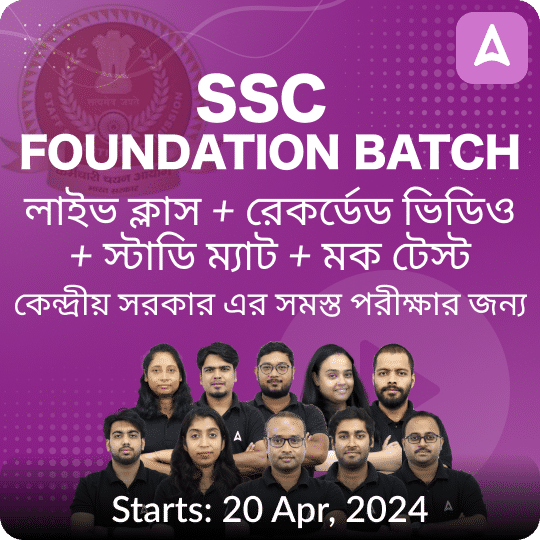Q1. অশোকের শিলালিপি সম্পর্কে নিচের কোনটি ভুল?
(a) এগুলি অত্যন্ত পালিশযুক্ত
(b) মনোলিথিক
(c) স্তম্ভগুলির শ্যাফ্ট টেপিং আকারের
(d) এগুলি স্থাপত্য কাঠামোর অংশ
Q2. গুপ্তদের জারি করা রৌপ্য মুদ্রার নাম হল:
(a) রুপাকা
(b) কার্শপান
(c) দিনার
(d) পানা
Q3. নিচের কোনটি প্রাচীন ভারতের ব্যবসায়ীদের কর্পোরেশন ছিল?
(a) চতুর্বেদিমঙ্গলম
(b) পরিষদ
(c) অষ্টাদিকগজ
(d) মণিগ্রাম
Q4. গ্রীক, কুশান এবং শক অনেকেই হিন্দু ধর্মের চেয়ে বৌদ্ধধর্ম গ্রহণ করেছিলেন কারণ:
(a) বৌদ্ধধর্ম তখন উন্নতির আরোহণে ছিল
(b) তারা যুদ্ধ ও সহিংসতার নীতি ত্যাগ করেছিল
(c) বর্ণভিত্তিক হিন্দু ধর্ম তাদের আকর্ষণ করেনি
(d) বৌদ্ধধর্ম ভারতীয় সমাজে সহজ প্রবেশাধিকার সরবরাহ করেছিল
Q5. অষ্টাঙ্গিক মার্গের ধারণাটি কিসের মূল প্রতিপাদ্য গঠন করে:
(a) দিপবমস
(b) দিব্যবদন
(c) মহাপরিনির্বাণ
(d) ধর্ম চক্র প্রবর্তন সুত্ত
Q6.নিম্নলিখিত বিবৃতি বিবেচনা করুন
1 সৌত্রান্তিক এবং সম্মিতিয়া ছিলেন জৈন ধর্মের সম্প্রদায়।
2 সর্বস্তিবাদিন বলেছিলেন যে ঘটনার উপাদান সম্পূর্ণরূপে ক্ষণিক নয়, তবে একটি সুপ্ত আকারে চিরকাল বিদ্যমান ছিল উপরোক্ত বিবৃতিগুলির মধ্যে কোনটি সঠিক ?
a)কেবল 1
b)কেবল 2
c)উভয় 1 এবং 2
d)1 বা 2 কোনোটিই নয়
Q7. নিম্নলিখিত দর্শনের মধ্যে কোনটি ভারতীয় দর্শনের ষড়পদ্ধতির অংশ তৈরি করে না?
(a) মিমামসা ও বেদান্ত
(b) ন্যায় এবং বৈষিকিকা
(c) লোকায়ত এবং কাপালিক
(d) স্মাখ্যা এবং যোগা
Q8. সিন্ধু সভ্যতার লোকেদের নিম্নলিখিত কোন বৈশিষ্ট্য ছিল?
a)তারা প্রাসাদ এবং মন্দিরের অধিকারী ছিল।
b)তারা পুরুষ ও স্ত্রী উভয় দেবদেবীর উপাসনা করত।
c)তারা যুদ্ধে ঘোড়া টানা রথ ব্যবহার করেছিল
d)উপরের কোনটিই সঠিক নয়
Q9. জৈন দর্শন অনুযায়ী কে পৃথিবী তৈরি করেছে এবং রক্ষণাবেক্ষণ করেছে?
(a) সর্বজনীন তত্ত্ব
(b) সর্বজনীন সত্য
(c) সর্বজনীন বিশ্বাস
(d) সর্বজনীন আত্মা
Q10. চীন ভ্রমণকারী ইউয়ান চুয়াং (হিউয়েন সাং) যখন ভারত ভ্রমণ করেছিলেন সে সময়কার সাধারণ পরিস্থিতি এবং সংস্কৃতি রেকর্ড করেছিল। এই প্রসঙ্গে, নিম্নলিখিত বিবৃতিগুলির মধ্যে কোনটি সঠিক?
a)রাস্তাঘাট এবং নদীপথগুলি ডাকাতির হাত থেকে সম্পূর্ণ নিরাপদ ছিল।
b)অপরাধের শাস্তি, আগুন, জল এবং বিষ দ্বারা অগ্নিপরীক্ষা কোনও ব্যক্তির নির্দোষ হওয়ার বা অপরাধ নির্ধারণের জন্য একটি ব্যবস্থা ছিল।
c)ব্যবসায়ীদের ফেরি এবং ব্যারিয়ার স্টেশনগুলিতে শুল্ক প্রদান থেকে অব্যাহতি দেওয়া হয়েছিল
d)উপরের সবগুলোই সঠিক

Solutions
S1.Ans.(d)
Sol.
Ashoka stone pillars were meant to spread his Dhamma (not the part of architectural structure.)
S2.Ans.(a)
Sol.
Rupaka was a silver coin of the Gupta period.16 Rupaka was equal to 1 gold coin.
S3.Ans.(d)
Sol.
A manigramam was a large, influential guild of South Indian merchants during the period of Western Chalukyan rulers in the 10th – 12th Century CE.
S4.Ans.(c)
Sol.
They embraced Buddhism because caste-ridden Hinduism did not attract them
S5.Ans.(d)
Sol.
The Noble Eightfold Path is one of the principal teachings of the Buddha, who described it as the way leading to the cessation of suffering (Dukkha) and attainment of self-awakening. In Buddhist symbolism, the Noble Eightfold Path is often represented by means of the Dharma wheel (Dharmachakra), whose eight spokes represent the eight elements of the path. The eightfold path includes right understanding, right speech, right livelihood; right mindfulness, right thought, right action, right effort and right concentration
S6.Ans.(b)
Sol.
Sautrantikas and Sammtiyas as Buddhism sects. So the first statement is wrong. And Sarvastivadin sect of Buddhism believes that all things exist, and exist continuously, in the past and the future as well as in the present. So second statement is right.
S7.Ans.(d)
Sol.
Lokayata and Kapalika do not form of Six systems of Indian philosophy
Samkhya Prakritiand Purush
Yoga Releasing Purush from Parkriti
Nyaya Logical thinking
Vaisheshika Realistic and objective philosophy of the universe
Mimamsa Analyzing Samhita and Brahmana portion of Veda.
Six systems of Indian philosophy are Vedanta It is the climax of Indian Philosophy
S8.Ans.(b)
Sol.
Indus Valley people did not possess great palaces and temples rather the civilization was noted for its cities built of brick, roadside drainage system and multistoried houses. Indus valley people were peace-loving. They were never engaged in any war. However, speculations have been rife that some tectonic forces destroyed the civilization. Some historians are of the view that invasion of Aryans, sea-level changes, earthquakes might have brought the civilization to its end therefore people employing horse-drawn chariots in warfare is not true. Moreover, Indus valley seals show swastika, animals which are suggestive of their religious beliefs. In view of a large number of figurines found in the Indus valley, some scholars believe they worshipped the mother goddess symbolizing fertility. They worshipped a father God who might be a progenitor of the race and was probably a prototype of Siva as the Lord of the Animals.
S9.Ans.(d)
Sol.
S10.Ans.(b)
Sol.
The tradesman had to pay duties at ferries and barriers. After paying the revenue they could go to and fro to barter their merchandise. The punishment for social offences according to the traveller’s account, was to cut off the nose, or an ear or a hand. Minor offences were dealt with fines. And to determine guilt or innocence, ordeals by fire, water and poison were the instruments that were used








